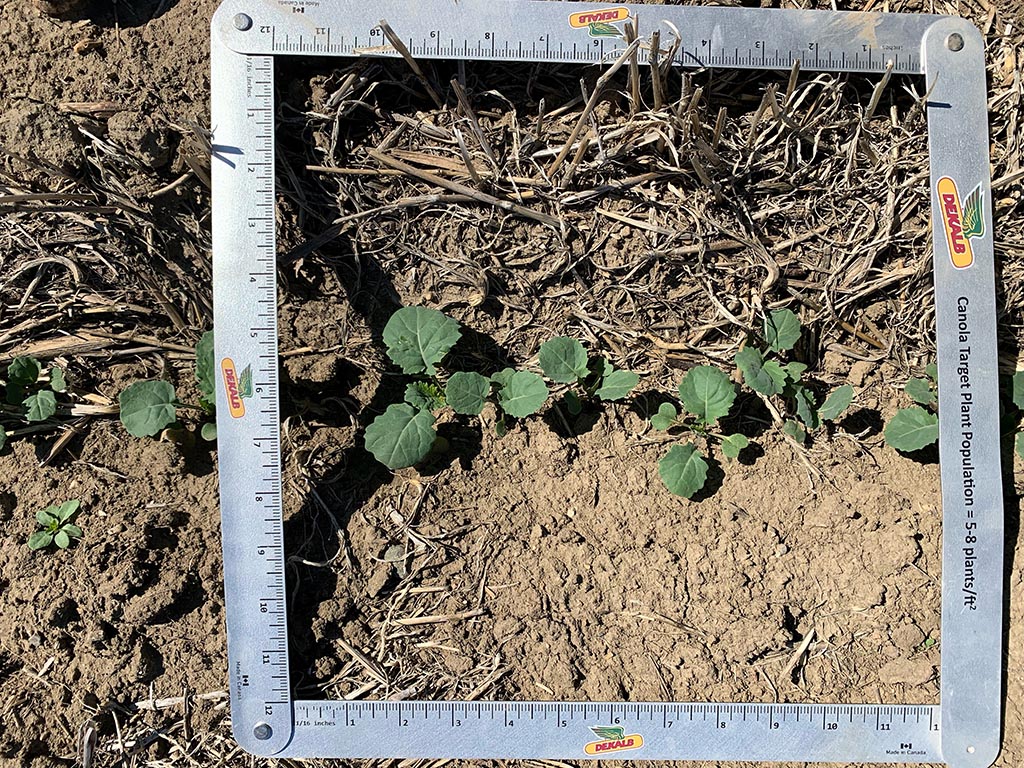Successful stand establishment of canola, like any crop, is dependent on weather and management decisions. Environmental effects like soil temperature and moisture, frost, and wind and hail can impact the stand. Management decisions such as planting date, seedbed preparation, seeding rate, planting speed, and seeding depth can also impact the stand.

Figure 1. Optimal canola stand.
Environmental effects
- A moist seedbed with a minimum soil temperature of 2 °C will initiate germination. Ideally, a temperature of 10 °C will provide quick germination and emergence. Initiate seeding when temperatures in the seed zone are at 4 to 5 °C, particularly when the forecast is for warming temperatures.
- Moist soil conditions are ideal for germination. Semi-dry seedbeds often result in slow, uneven germination and abnormal seedlings. If seeding into dry conditions in the early spring, plant seeds to a depth of 1.25 to 2.5 cm as there is still time for rain to provide moisture for germination. However, there are risks with this strategy: drier soil requires a deeper seeding depth, which means a longer distance to emerge, and may reduce the stand because of seedling death prior to emergence.
- Rainfall events followed by sunny and warm days can result in soil crusting that stops the seedlings from reaching the surface. The options for breaking the crust are limited, and if the stand reaches 20 plants per square meter in late May to early June, it can be an economically viable stand. However, if it is early May and the stand is not adequate, reseeding may be the best option.
- Wind can shear off the seedling, or soil particles can blast the seedling, resulting in seedling mortality. This is usually more of a concern on light-textured, dry soils and on exposed areas of the field. If the stand is uniformly reduced across the field, reseeding may be necessary, but usually only small areas are damaged in this manner, and if the stand is still above 10 to 20 plants per square meter, the stand should be adequate.
- Early-season hail can snap off the cotyledons or break the stems, resulting in plant death. Canola can compensate for reduced stands, particularly if the stand is reduced early in the season. If the stand is below the optimal level of 30 to 40 plants per square meter, the remaining plants can compensate, but the stand will most likely not reach maximum yield, as the thin stand will not be competitive against weeds.
- Keep in mind the risk of frost when choosing a seeding date. The frost-free period varies considerably from location to location, and each year is different. Also, the dates of the final spring frost and first fall frost often vary between years. The temperature at which frost injury occurs is dependent on the moisture content within the tissue, the length of time the temperature is below the critical level, the previous weather conditions, and the insulating effects of the soil surface.
- A light frost (0 °C to -2 °C) that does not damage the growing point will not impact yield. A light frost may result in wilted leaves, but likely will not discolor tissue.
- If a frost results in blackened cotyledons and/or leaves, wait at least 4 days under ideal growing conditions, and as long as 10 days if growing conditions are
poor, to assess the crop. If after waiting the hypocotyl is still attached and not constricted or if the growing point is showing any green coloration, the plants will
recover.
- After waiting to assess regrowth, if the majority of the field has 20 to 40 recovering plants per square meter with minimal weeds, re-seeding should not be necessary.
Management effects
Seeding rate (pounds) = 9.6 X target plant density X test weight (grams/1000 seeds)
% Plant emergence
Additional sources of information
The Canola Council of Canada has some excellent calculators to assist in establishing canola stands; they can be found at https://www.canolacouncil.org/calculator/
Sources:
2022. Plant establishment. Canola Encyclopedia. Canola Council of Canada. https://www.canolacouncil.org/canola-encyclopedia/plant-establishment/
Legal Statements
Performance may vary from location to location and from year to year, as local growing, soil and weather conditions may vary. Growers should evaluate data from multiple locations and years whenever possible and should consider the impacts of these conditions on the grower’s fields.
Bayer and Bayer Cross are registered trademarks of Bayer Group. Used under license. All other trademarks are the property of their respective owners. ©2022 Bayer Group. All rights reserved. 2014_15246